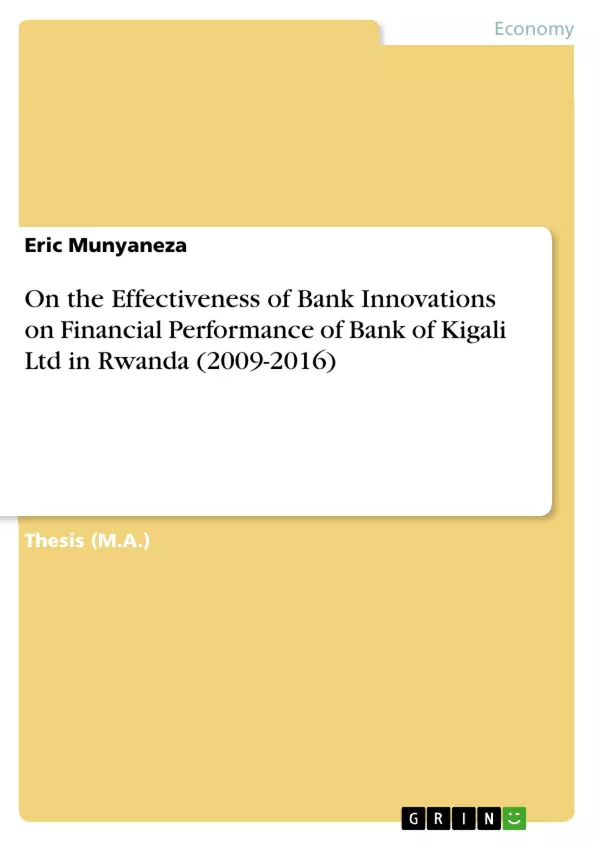This work analyzes the effectiveness of bank innovations on financial performance of Bank of Kigali Ltd in Rwanda (2009-2016). Banking innovation has played an important role in improving service delivery standards in the Banking institution. In its simplest form, Automated Teller Machines (ATMs), POS, credit cards, mobile banking and other deposit machines now allow consumers carry out banking transactions beyond banking hours. The main objective of the study was to establish the effectiveness of bank innovations on financial performance of Bank of Kigali Ltd in Rwanda.
The population under study is 35 staffs of Bank of Kigali Ltd to be given questionnaires and interviewed. A descriptive survey research design was adapted where a total sample of 35 respondents was selected. The primary data were collected using structured questionnaires and interview to address the effect of banking innovation on financial performance of Bank of Kigali. Consequently, both qualitative and quantitative data were collected. The first hypothesis of the study was analyzed on effect of bank innovation on income of Bank of Kigali Ltd.
The findings shows 35 staffs of Bank of Kigali Ltd have responded to the administered questionnaire, their mean on the ATM, POS, credits and debit cards, mobile banking internet banking, electronic fund transfer, and digital innovation are strong and their standard deviation are heterogeneity. The second hypothesis was verified where the bank innovations performance were indicated that customers, deposits, incomes increased year to years, loans to assets respect the standard of BNR which says that loans does not exceed 80% of customer deposit and ROE ratio is the following: 29%, 19%, 16%, 19%, 21%, 20%, 21% and 24% respectively. The third hypothesis of the study was to establish the comparison of bank innovations and performance of Bank of Kigali Ltd where before innovation where before innovation number of customers were 135,564 from 2009 while after establishing innovation become 262,284 in 2016. The branches, POS, Mobibank, and ATM have been increased after implementation of innovation in Bank of Kigali. The fourth hypothesis which determines the correlation between bank innovation and performance of Bank of Kigali revealed that there is a strong relationship between two variables which means banking innovation contributed to the performance of Bank of Kigali.
Inhaltsverzeichnis (Table of Contents)
- Chapter 1: Introduction
- 1.1 Background of the Study
- 1.2 Statement of the Problem
- 1.3 Research Objectives
- 1.4 Research Questions
- 1.5 Significance of the Study
- 1.6 Scope of the Study
- 1.7 Limitations of the Study
- 1.8 Organization of the Study
- Chapter 2: Literature Review
- 2.1 Innovation in Banking
- 2.2 Banking Innovations and Financial Performance
- 2.3 Factors Influencing Banking Innovation
- 2.4 The Rwandan Banking Sector
- 2.5 Bank of Kigali Ltd
- Chapter 3: Methodology
- 3.1 Research Design
- 3.2 Population and Sample
- 3.3 Data Collection Techniques
- 3.4 Data Analysis Techniques
- Chapter 4: Data Presentation and Analysis
- 4.1 Data Presentation
- 4.2 Analysis of Banking Innovations
- 4.3 Analysis of Financial Performance
- 4.4 Relationship between Banking Innovations and Financial Performance
- Chapter 5: Discussion of Findings
- 5.1 Summary of Findings
- 5.2 Discussion of Findings
- 5.3 Implications of the Findings
Zielsetzung und Themenschwerpunkte (Objectives and Key Themes)
This research aims to explore the impact of banking innovations on the financial performance of Bank of Kigali Ltd in Rwanda from 2009 to 2016. It seeks to identify specific innovations implemented by the bank, assess their effectiveness, and establish the relationship between these innovations and the bank's financial performance.- The role of banking innovations in enhancing financial performance
- The impact of specific innovations on key financial indicators
- The relationship between innovation adoption and financial performance
- The factors that drive innovation in the Rwandan banking sector
- The challenges and opportunities associated with implementing banking innovations
Zusammenfassung der Kapitel (Chapter Summaries)
Chapter 1 introduces the research by providing a background on banking innovations and their importance in the modern financial landscape. It also outlines the problem statement, research objectives, research questions, and significance of the study. Chapter 2 presents a comprehensive literature review covering various aspects of banking innovation, including its impact on financial performance, factors influencing innovation adoption, and the specific context of the Rwandan banking sector. Chapter 3 details the research methodology employed in the study, covering the research design, population and sample selection, data collection techniques, and data analysis methods. Chapter 4 presents the collected data and analyzes the banking innovations implemented by Bank of Kigali Ltd, as well as the bank's financial performance over the study period. It further explores the relationship between these innovations and the bank's financial performance. Chapter 5 discusses the key findings of the study, highlighting their implications for the banking sector and suggesting recommendations for future research and practice.Schlüsselwörter (Keywords)
The study focuses on the intersection of banking innovation, financial performance, and the Rwandan banking sector. Key terms and concepts explored include financial innovation, banking efficiency, return on assets, return on equity, net profit margin, and market value added. The research delves into the impact of specific innovations such as electronic banking, mobile banking, and ATM networks on the financial performance of Bank of Kigali Ltd.- Citar trabajo
- Eric Munyaneza (Autor), 2017, On the Effectiveness of Bank Innovations on Financial Performance of Bank of Kigali Ltd in Rwanda (2009-2016), Múnich, GRIN Verlag, https://www.grin.com/document/492258



